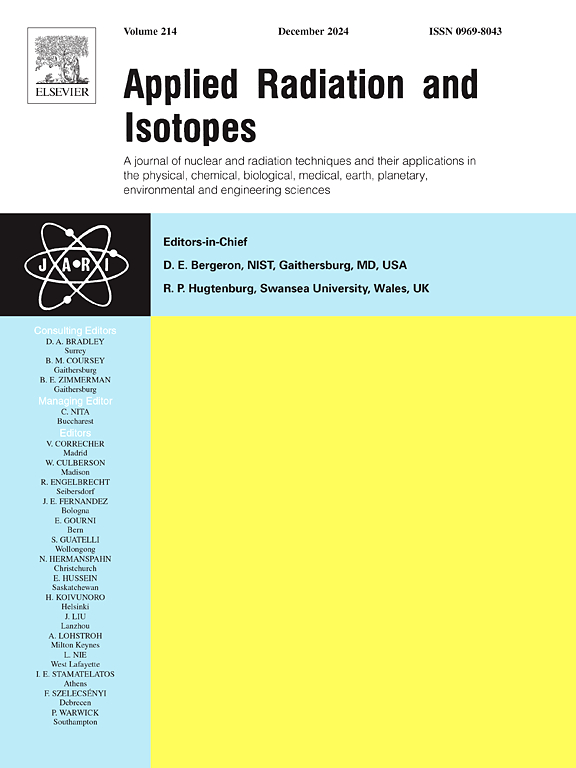A novel dual-chamber cyclotron target for simultaneous production of F-18 and P-32
IF 1.8
3区 工程技术
Q3 CHEMISTRY, INORGANIC & NUCLEAR
引用次数: 0
Abstract
This study presents a novel cyclotron-based method for the simultaneous production of fluorine-18 (F-18) and phosphorus-32 (P-32) using a dual-chamber target system. Monte Carlo simulations with PHITS and DCHAIN were employed to model F-18 production via the 18O(p,n)18F reaction in an H218O target and secondary P-32 production through the 32S(n,p)32P reaction in a sulfur-filled chamber. Four geometric configurations were analyzed to optimize neutron flux and isotope yields. The most effective design (0.75 cm × 1.20 cm) yielded 2.2342 ± 0.0008 GBq/μAh of F-18 and 0.0261 ± 0.0026 MBq/μAh of P-32, with radionuclidic impurities remaining below 0.1 %. A conservative ±10 % uncertainty was applied to P-32 yields to account for modeling variation in secondary neutron flux, while F-18 uncertainties reflect PHITS statistical precision. Additional simulations at 8–13 MeV confirmed 13 MeV as the optimal energy within the DECY-13 cyclotron's capabilities. Thermal and structural analyses using ANSYS confirmed safe operation at 25 μA for 1 h, without exceeding material or target limits. The proposed system provides a compact and efficient solution for co-producing F-18 and P-32, potentially enhancing radioisotope production workflows in medical and research settings.
用于同时生产F-18和P-32的新型双腔回旋靶
本研究提出了一种基于回旋加速器的新方法,利用双腔靶系统同时生产氟-18 (F-18)和磷-32 (P-32)。利用PHITS和DCHAIN进行蒙特卡罗模拟,模拟了在H218O靶中通过18O(p,n)18F反应生成F-18的过程,以及在硫磺填充腔中通过32S(n,p)32P反应生成p -32的过程。分析了四种几何构型,以优化中子通量和同位素产率。最有效的设计(0.75 cm × 1.20 cm) F-18和P-32的产率分别为2.2342±0.0008 GBq/μAh和0.0261±0.0026 MBq/μAh,放射性核素杂质含量低于0.1%。P-32产率采用保守的±10%的不确定性来解释二次中子通量的建模变化,而F-18的不确定性反映了PHITS的统计精度。在8-13 MeV下的额外模拟证实了13 MeV是DECY-13回旋加速器能力范围内的最佳能量。利用ANSYS进行的热分析和结构分析证实,在25 μA的温度下安全运行1小时,不超过材料或目标限值。该系统为联合生产F-18和P-32提供了一种紧凑而高效的解决方案,有可能增强医疗和研究环境中的放射性同位素生产工作流程。
本文章由计算机程序翻译,如有差异,请以英文原文为准。
求助全文
约1分钟内获得全文
求助全文
来源期刊

Applied Radiation and Isotopes
工程技术-核科学技术
CiteScore
3.00
自引率
12.50%
发文量
406
审稿时长
13.5 months
期刊介绍:
Applied Radiation and Isotopes provides a high quality medium for the publication of substantial, original and scientific and technological papers on the development and peaceful application of nuclear, radiation and radionuclide techniques in chemistry, physics, biochemistry, biology, medicine, security, engineering and in the earth, planetary and environmental sciences, all including dosimetry. Nuclear techniques are defined in the broadest sense and both experimental and theoretical papers are welcome. They include the development and use of α- and β-particles, X-rays and γ-rays, neutrons and other nuclear particles and radiations from all sources, including radionuclides, synchrotron sources, cyclotrons and reactors and from the natural environment.
The journal aims to publish papers with significance to an international audience, containing substantial novelty and scientific impact. The Editors reserve the rights to reject, with or without external review, papers that do not meet these criteria.
Papers dealing with radiation processing, i.e., where radiation is used to bring about a biological, chemical or physical change in a material, should be directed to our sister journal Radiation Physics and Chemistry.
 求助内容:
求助内容: 应助结果提醒方式:
应助结果提醒方式:


